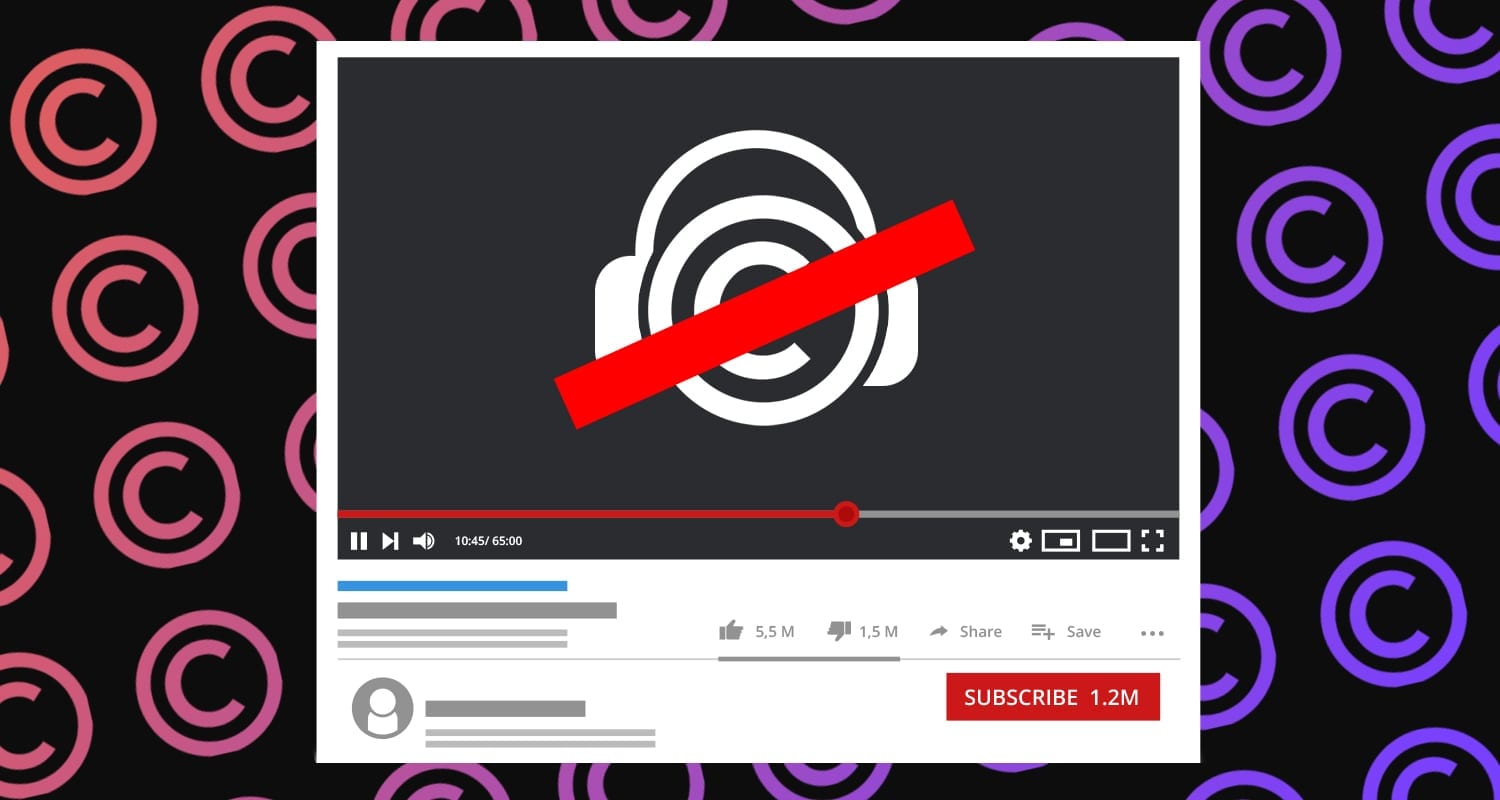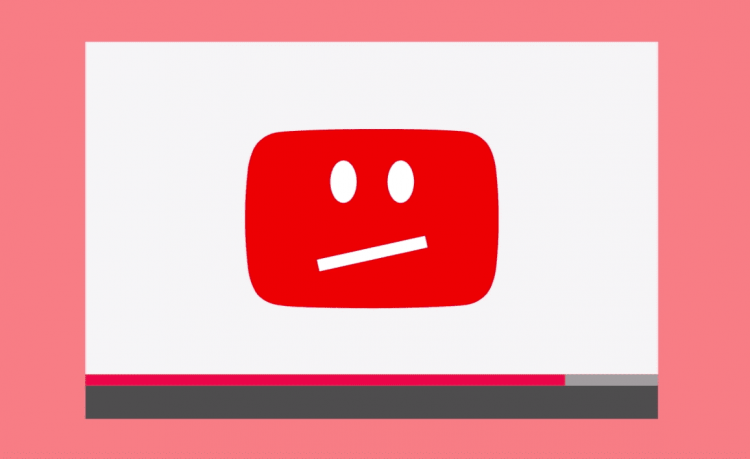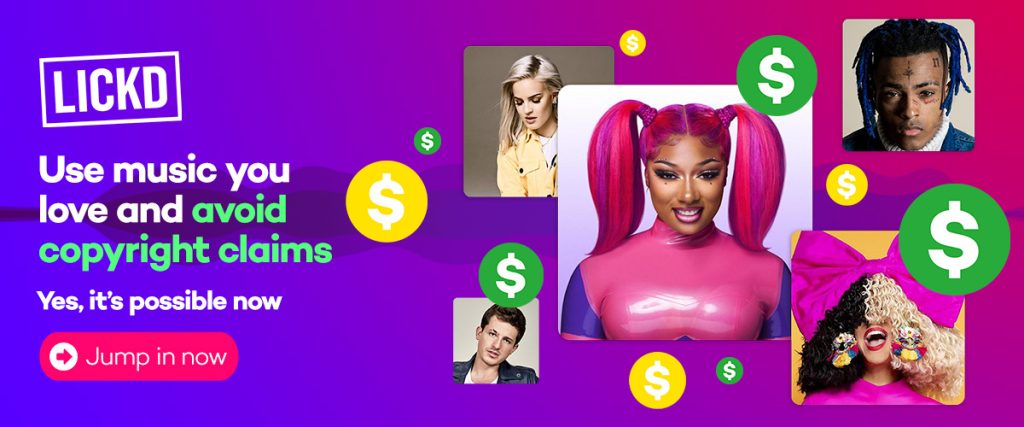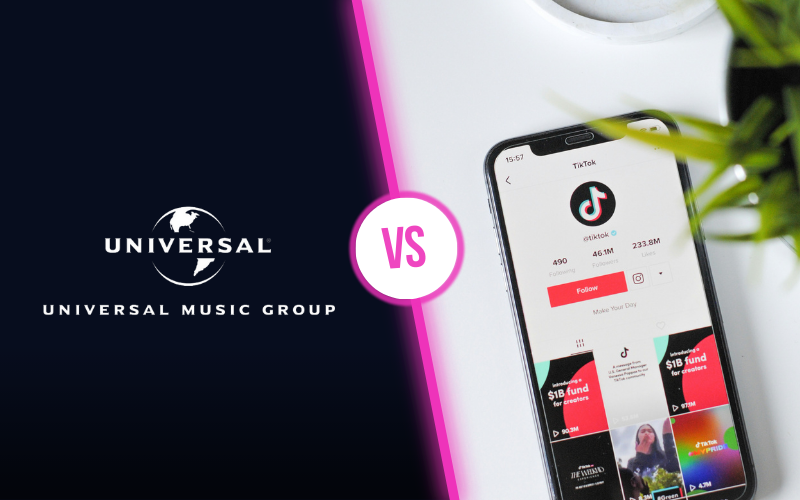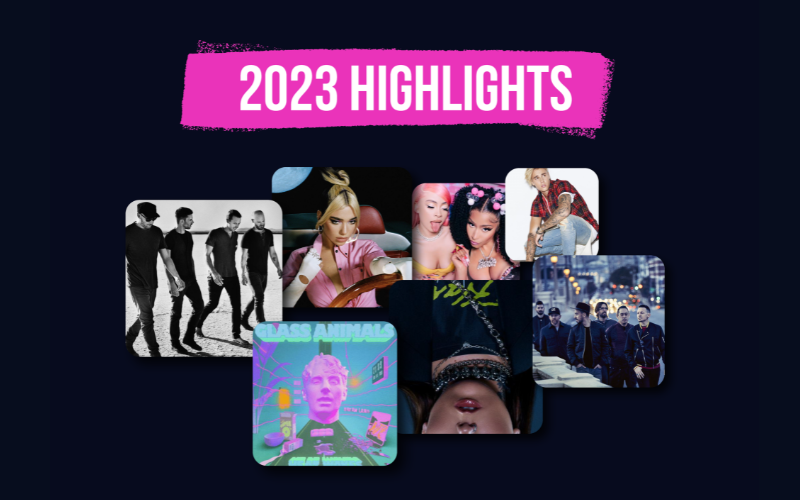The only thing worse than not being able to find the right music to go with your video content is to get handed a copyright infringement claim after using a song that you don’t have the license to use!
It’s a killer – you’ve spent hours, if not days, crafting the perfect YouTube video only to find that someone else is entitled to all of the revenue generated and even able to order the removal of your content from the platform entirely.
Avoiding ending up in a sticky situation like this comes down to understanding the what and how of copyright law. It can be a daunting topic to get your head around, but don’t worry! Lickd’s team of experts is on hand to help you get to grips with everything you need to know about copyright on YouTube and, more importantly, how to avoid being on the receiving end of copyright infringement claims!
So, what are you waiting for? Keep reading to learn all about crucial topics relating to avoiding copyright claims on YouTube, including:
- How music copyright works on YouTube
- What happens when you infringe on YouTube’s copyright rules
- What are the wrong ways to go about avoiding copyright claims?
- What are the right ways to avoid copyright claims on YouTube?
If you’re looking for more of an introduction to the issue, check out our other blog post for a full overview of copyright rules on YouTube.
YouTube’s copyright policies – what are they, and how do they work?
The main thing to understand about YouTube’s copyright policies is that they are much, much bigger than YouTube itself. As a content-sharing platform, YouTube simply upholds copyright laws that cover the whole content creation industry. It’s not YouTube that is making the decision to put a copyright claim on one of your videos; it’s merely following the rules by holding offenders accountable if they use someone else’s materials without permission.
In order to make this process possible across the whole platform, YouTube uses a system called Content ID. Imagine Content ID as a sophisticated version of Shazam. Just like how Shazam scans your environment for audio that matches its database, Content ID scans the audio of every video uploaded to YouTube. If any part of a video’s soundtrack matches audio files registered to the Content ID database, it can trigger a copyright claim automatically.
Let’s break it down and take a closer look at how Content ID technology works in practice.
1. Creators register their song or video with Content ID and become the copyright holder for that particular piece of intellectual property
Say one of your favorite singer-songwriters creates and records a song called Don’t Infringe Me No More; they could register that song with Content ID. Then, it’s in the Content ID database. You may want to use the song in your video, but Content ID will now be able to find out if you do.
2. Content ID tracks down copyright infringements
After a copyright owner registers their copyright with Content ID, YouTube regularly sends a virtual police force to search for unauthorized uses of it. So, if you’ve uploaded a video with Don’t Infringe Me No More in the background and you don’t have permission to use it, Content ID will hunt you down.
3. YouTube applies a copyright claim
If you’re found to be in breach of copyright law, you will get a copyright claim applied to your video in the form of a copyright strike. This is not something you want – let’s take a look at the consequences.
What happens if you break YouTube’s copyright policies with your content?
So, let’s say you choose to ignore all the advice and use copyrighted music without permission from the owner. When the holder of the copyright finds out that you’ve used their work unlawfully, you’ll likely get handed a copyright claim against your content. This can result in the following things happening to your video.
- Demonetizing your content – The most common result of a copyright infringement claim is monetization…but not by you! If the copyright holder learns that you’re using their music without permission, they are within their rights to monetize your video and claim all proceedings it generates instead of you.
- Muting your content – If the copyright owner chooses not to monetize your content, it’s likely that they’ll still choose to mute it if it’s using an audio file or song without permission. This means that your video will still be available to watch, but it won’t have any sound in the snippet where the copyrighted song should be. Audio is one of the most important aspects of successful YouTube videos, so not having any on your content could lead to a serious drop in view counts.
- Tracking your content – The owner of the copyright can choose to track your content’s viewer statistics without taking further action. Whilst this doesn’t sound too bad, don’t rely on it happening to you, as it’s the least likely result of copyright infringement claims.
- Blocking your content – The most permanent action that the copyright holder can take against your content is blocking it altogether. This means that it will become unavailable on YouTube and may lead to your entire channel being penalized. Imagine all the hard work you put into planning, filming, editing and uploading a video, only to have it removed from public view entirely! Definitely something you want to avoid right? We’ll explain how in a minute!
What are copyright strikes on YouTube?
YouTube issues ‘strikes’ against content that has had a complete and valid legal takedown request submitted against it. This enables the platform to remove the content in line with copyright law. The first strike you receive acts as a warning and requires the at-fault party to go through Copyright School to prevent further offenses from happening in the future.
If your content is issued with a copyright strike, there are three ways in which you can resolve it.
- Wait for it to expire – copyright strikes automatically expire after a period of 90 days.
- Get a retraction – you can contact the user who submitted the Content ID claim and request that they retract their infringement claim.
- Submit a counter-notification – if you think that your video was removed by mistake and that you didn’t actually breach copyright rules, you can submit a counter-notification and appeal the strike.
How are copyright strikes different from claims?
A YouTube copyright claim has less serious consequences than a strike. With a claim, you get a notification that the owner of the material you’re using has flagged it as theirs.
However, a YouTube copyright strike has more serious consequences.
You’ll receive a strike when a copyright owner requests that YouTube removes a video that uses their material unlawfully.
If you get three YouTube copyright strikes, your account may be terminated. A poor track record with strikes can also negatively impact your channel by reducing your ability to monetize content and use certain features on the platform.
What are the wrong ways to try and avoid receiving copyright claims and strikes?
Perhaps you consider yourself a smooth operator, able to pull off some fancy schemes to avoid paying for music on YouTube. Alas, trying to trick the almighty Content ID is rarely successful. It’s like trying to talk your way out of getting grounded after coming home at 3 am with a dented car. It’s not happening.
Even if you get away with infringement temporarily, YouTube’s algorithms are constantly becoming more advanced, and you’re bound to get caught out eventually.
Here are some common less-than-wholesome strategies some people suggest for how to avoid copyright on YouTube.
1. Writing “I claim no rights to this song.”
How many times have you seen a YouTube Creator say they don’t own rights to the song they’re using? Many. How many times does it work? Zero.
Unfortunately, this strategy is useless. Think about it this way: If you walked into a shoe store, snagged a pair and walked out the door, admitting you don’t claim any rights to the shoes, would that work? Absolutely not. You don’t need to say you don’t own any rights to a song; the copyright owner already knows that. At this point, you’re just advertising that you’re using the music illegally.
Giving credit to the content owners when using copyrighted material also doesn’t work, although you may have to do this when you get a license.
2. Changing the speed/pitch of the music
With everyone and their mom becoming amateur music producers these days, you won’t have a hard time finding someone who can warp a copyrighted song, so it sounds just a little different. The idea is that Content ID won’t be able to recognize the audio after you’ve changed it ever so slightly.
This bad-faith strategy suffers from various pitfalls:
- First, as a Creator, you’re blatantly disregarding the rights of other creatives. It’s one thing if you’re not aware of copyright law, but it’s another to commit copyright infringement so openly.
- Secondly, warping audio can distort quality and ruin the experience for your viewers, meaning they’re less likely to watch your content again, and they may be less willing to like or subscribe.
- Finally, as we said earlier, Content ID keeps getting better and better. YouTube is aware of these tricks and is constantly improving its algorithm to catch this kind of usage. The new algorithms can often recognize altered versions of original songs. If you’ve got away with it now, it’s only a matter of time before you’re found out.
3. By just playing a snippet of the track
This is just a fool’s errand. If you’re thinking of ‘just playing two seconds’ of the track because, supposedly, that won’t trigger a claim, you’re playing with fire. And for what, really? Is it worth having your entire video demonetized for 2 seconds of audio?
The above three methods, though the intent of avoiding copyright violation is there, will still likely result in legal action being taken by the content owners. If you want to know how to avoid a copyright claim on YouTube, the answer is simple: either don’t use any or actually get permission. Do you know, it’s not actually that hard to get permission to use the real deal? You won’t get copyrighted, and you get a lot more out of it than just two seconds. Keep reading to find out how!
How to not get copyrighted on YouTube (properly)

This all probably sounds really limiting, and we’re here to tell you not to worry! There’s actually plenty of music kicking about for you to spice up your videos with; you just need to make sure you use it properly.
So, what music can you use on YouTube if you want to avoid copyright infringement while still making kick-ass content? There are a couple of different types of music you can get that are suitable for YouTube.
The historical way, the workaround: stock music
You might have heard of royalty-free music or ‘stock music’ before. This is the most commonly used music on YouTube over the years.
You’ll likely pay a subscription fee to access a music library of tracks that you can use on YouTube. All without getting a copyright claim or having to pay ongoing royalties. YouTube Audio Library is one example.
Sadly, these tracks usually leave a lot to be desired, and most ‘good’ royalty-free tracks you’ll find are overused. So, although you will avoid copyright violations, your YouTube video may not live up to its potential. Stock music was only introduced as a workaround solution to allow you to use at least some kind of music in the background of your video. But it doesn’t actually solve the original problem of why creators get copyright claims. Now, there’s a solution that does, so you don’t have to settle for shit stock music anymore!
The new way: popular music!
Did you know it’s actually possible to use popular, mainstream music on YouTube now too? Without getting copyright claims?
Lickd is a music library created especially for creators, allowing you to legally use popular music in your YouTube videos for the very first time. We did what no one else bothered to do, we leveraged our connections with the music industry to convince big record labels and publishers to make their music available to you. Now, you can choose from over a million songs from the likes of Charlie Puth, Sia, Megan Thee Stallion, Panic! At The Disco, XXXTentacion, Bazzi, Jess Glynne and many, many others – and NOT get copyrighted on YouTube.
You still don’t have to pay ongoing royalties or worry about copyright claims, but you get all the benefits of using music that your viewers will actually recognize.
So what are the benefits of using popular music?
Using popular music can give your video a big boost! In fact, it’s been shown to increase ALL important YouTube metrics. Likes, comments, subscribes, watch time, you name it. It’s a relatively new development, so if you get in early, you can set yourself apart from the rest with the freshest music.
Ultimately, here at Lickd, we just want to see you succeed. That’s why we made it possible for you to finally be able to use popular music in your YouTube videos. Legally and without worries of copyright claims stunting your video views and channel growth!
On top of that, you can also access stock music – the world’s largest stock music library for creators, to be exact! And quantity doesn’t mean lower quality. This stock music has also been used in TV and movies… yeah we’re not playing around! Guess what? Because we love creators so much, you’ll get 25% off your first mainstream music track and free unlimited stock music for 14 days. Get on it via the link below.
Not yet convinced? The numbers speak for themselves, but here are a few other options for you.
Pond5
If you’ve got some cash to spend, then Pond5 could work for you. You’ll be able to search a library of around 15,000 tracks, and you should be able to find something for between $20 and $60. It offers background music and sound effects for your YouTube videos, but bear in mind these are only stock music tracks.
PremiumBeat
This is owned by Shutterstock, who you’ve probably heard of if you’ve ever needed a photo for something. As with the photos, you’ll find a huge selection of stock music, but there’s no scaled pricing. You’re looking at $49 per track regardless of your audience or the quality of the song, which can be a little steep. (Especially when you consider it’s just stock music, and you could license Charlie Puth or Lizzo instead for as little as $8…).
The great news is that royalty-free music libraries can give you access to tracks for other platforms too. You can grab stock music for Instagram or stock music for Facebook easily too.
While traditional royalty-free music libraries can be helpful, they often provide unknown background music. For example, PremiumBeat offers a wide selection of user-submitted music. However, you’re unlikely to find any tracks from big-name artists. While stock music certainly serves a purpose, sometimes you want to differentiate your videos with a hit song. Otherwise, your videos will sound like everyone else’s.
Tips for avoiding copyright claims:
Finally, here are a few other tips to make sure you don’t get copyrighted:
1. Only use content that you’ve created yourself
Another way to avoid copyright infringement and strikes is to only use your own content on YouTube. If you only use music and videos that you’ve created yourself, you won’t have to worry about copyright claims as you’ll be the copyright owner. However, obviously, it depends if you have the skills, equipment and time to write and record your own music to use in the background of your videos – as well as create the entire video yourself.
2. Stick within the ‘fair use’ policy
You may well have heard the term ‘fair use’ being thrown about, and while it may sound like your free ticket to using whatever tracks you want in your content, it’s probably not. Fair use may allow you to add a track and not receive a claim, but it’s unlikely.
Usually, fair use applies if you’re using copyrighted content for non-profit educational purposes, but even then, it depends on the content you’re using, how much of it you’re using, and the effect that your video may have.
So, every fair use case is judged differently, and what may pass as fair use for one person may not be judged as fair use for another.
Now you know how to avoid getting copyrighted on YouTube
Lickd is the holy grail for mainstream music for content creators. Say goodbye to worrying about copyright infringement on YouTube. Unlike standard music libraries, Lickd has popular music people will recognize in an instant, giving your video an extra boost.
Get copyrighted music from the biggest artists at affordable prices and avoid breaching copyright law. You can search Lickd by artist, theme, genre, or even the type of video you’re producing. Pay per song for ultimate flexibility.
Sign up and start creating high-quality content without fear of copyright infringement. Even better, get a 14-day free trial of Lickd’s subscription and a 25% welcome discount for your first mainstream track
FAQs
Why does YouTube copyright music?
As we mentioned earlier, YouTube itself doesn’t copyright music; it enforces the copyright that artists have to their own songs. If they didn’t do this, then artists and record labels would come after YouTube and Google themselves.
Just as YouTube Creators would seek payment if someone else wanted to use the content they’d created, music artists want to be compensated when someone uses their work too.
For more information, check out this beginner’s guide to YouTube Music Policies.
What can you do to avoid copyright infringement on YouTube?
There are a number of ways to avoid violating copyright rules on YouTube. The main, most effective ones are:
- Get permission to use popular music from a licensing service provider like Lickd!
- Make and use your own music
- Try royalty-free music
How long does a copyright strike last?
YouTube copyright strikes expire after 90 days. After this time, they will be erased.
How do you resolve a copyright claim on YouTube?
You have 3 options when it comes to resolving copyright claims made against your content. These are:
- Wait for it to expire and be erased after a period of 90 days.
- Contact the holder of the copyright and ask them to retract the claim against your content.
- Submit a counter-notice against the original claim if you feel that it has been issued unfairly.
What happens if you get 3 copyright strikes on YouTube?
If you receive 3 copyright strikes, your account and any channels associated with it will be terminated. This means all of the videos on any of the created channels will be removed, and new channels cannot be created.
Can I avoid copyright claims by putting disclaimers in my video descriptions?
In short, no, you can’t avoid copyright claims on YouTube simply by putting a disclaimer in the description section of your videos. In order to make sure that you and your channel are both protected against infringement claims, you’ll need to seek adequate permission from the owner of the song or sound file you’re using in your videos or solely use royalty-free music.
